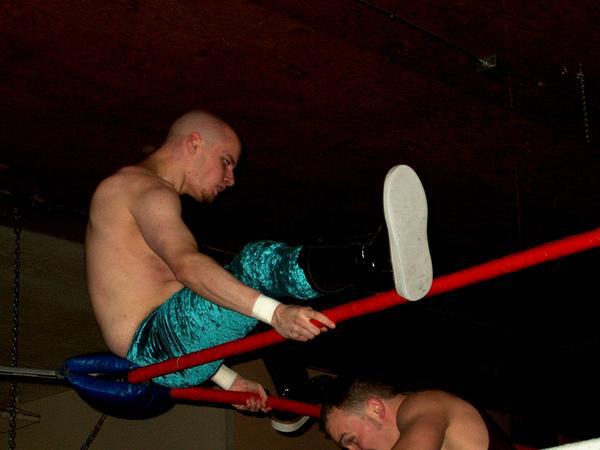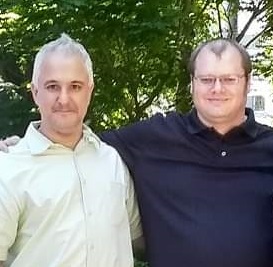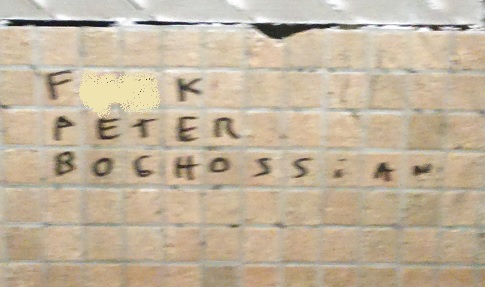 The Science and Pseudoscience of Violence by Brandon Smith, posted April 16, 2025:
The Science and Pseudoscience of Violence by Brandon Smith, posted April 16, 2025:
While my knowledge of the natural sciences was rather limited prior to enrolling in Peter Boghossian's PHL 306U “Science and Pseudoscience” course in 2015, I was pleasantly surprised that its curriculum touched on a topic with which I was more familiar given my experience as a wrestler: combat sports. It quickly became clear to me that Peter was at least equally enthusiastic about the topic. The former “canceled” Portland State philosophy professor, who holds a purple belt in Brazilian Jiu-Jitsu (BJJ), has recently produced a YouTube series with Straight Blast Gym founder and BJJ black belt holder Matt Thornton, who authored The Gift of Violence in 2023 and spoke to the class as a guest lecturer. It is unfortunate for current Portland State students that Peter resigned from the university following a controversial run-in with its Institutional Review Board which constrained his ability to conduct research on human subjects, but the vital knowledge he and Matt have shared regarding the scientific reality of violent encounters warrants wide consideration from fans of more flashy big-screen fighting who may find themselves in a legitimately lethal situation.
 The focus of Peter Boghossian's Science & Pseudoscience class was the application of the scientific method (the utilization of experimentation and testing to impartially determine the factuality of a claim) in order to debunk pseudoscientific claims (assertions erroneously considered to be based on the scientific method). Knowing of Peter's 2013 book A Manual for Creating Atheists, I was unsurprised to hear him declare that faith-based (rather than evidence-based) belief processes produce unreliable conclusions.
The focus of Peter Boghossian's Science & Pseudoscience class was the application of the scientific method (the utilization of experimentation and testing to impartially determine the factuality of a claim) in order to debunk pseudoscientific claims (assertions erroneously considered to be based on the scientific method). Knowing of Peter's 2013 book A Manual for Creating Atheists, I was unsurprised to hear him declare that faith-based (rather than evidence-based) belief processes produce unreliable conclusions.
However, I was stimulated by his invitation of local martial arts expert Matt Thornton to speak to the class about “Aliveness.” Thornton explained to the class that most martial arts, including Aikido, Kung Fu, and Tai Chi, are undependable methods of self-defense despite the claims of their proponents because they are not designed to be used against resisting opponents. He added that techniques found in combat sports, such as Brazilian Jiu-Jitsu, boxing, and Muay Thai, are functional forms of self-defense due to their quality of “Aliveness,” that is, their ability to respond to unpredictable and uncooperative opponents. This concept was easy for me to grasp as a graduate of professional wrestling school, where the objective generally was to cooperate with at least one opponent in the context of a choreographed or perhaps artistically improvised wrestling match to convey an entertaining story to an audience. When it came time during training to “shoot,” or competitively try to outwrestle one another without regard to scripted sequences or predetermined outcomes, trainees attempted to execute maneuvers from amateur wrestling or Jiu-Jitsu on each other until one competitor submitted. I could understand that an individual would likely put themselves in great danger by confronting a violent attacker with nothing more than showy pro wrestling moves like clotheslines and body slams since they largely lack the functionality to subdue unaccommodating adversaries.
 Thornton expands upon his concept of Aliveness in his 2023 Pitchstone Publishing release, The Gift of Violence: Practical Knowledge for Surviving and Thriving in a Dangerous World. In addition to having the ability to repel an unpredictably timed attack from an unobliging assailant, Thornton adds that an Alive delivery system, or functional martial art, must be adaptable to resistance from opponents of various skill levels who utilize a variety of techniques in their attack. He contrasts such a system with traditional, or “fantasy-based,” martial arts that are based on mythology and dogma and consist of rigid, robotic patterns practiced against choreographed opposition. Thornton compares Aliveness to the scientific method in that it exposes the type of self-deception that may lead a strictly traditional martial artist to conclude that they are a competent fighter in the same manner that rigorous experimentation can betray a flawed hypothesis. He notes that “ideas about punching, kicking, wrestling, and grappling are all testable—you need only a resisting opponent to begin to discover objective answers” (pg. 64). He terms the method of testing such ideas “the opponent process,” as it entails the employment of conceptualized fighting techniques against an actively aggressive adversary in order to discover best practices in hand-to-hand combat and replicable self-defense strategies.
Thornton expands upon his concept of Aliveness in his 2023 Pitchstone Publishing release, The Gift of Violence: Practical Knowledge for Surviving and Thriving in a Dangerous World. In addition to having the ability to repel an unpredictably timed attack from an unobliging assailant, Thornton adds that an Alive delivery system, or functional martial art, must be adaptable to resistance from opponents of various skill levels who utilize a variety of techniques in their attack. He contrasts such a system with traditional, or “fantasy-based,” martial arts that are based on mythology and dogma and consist of rigid, robotic patterns practiced against choreographed opposition. Thornton compares Aliveness to the scientific method in that it exposes the type of self-deception that may lead a strictly traditional martial artist to conclude that they are a competent fighter in the same manner that rigorous experimentation can betray a flawed hypothesis. He notes that “ideas about punching, kicking, wrestling, and grappling are all testable—you need only a resisting opponent to begin to discover objective answers” (pg. 64). He terms the method of testing such ideas “the opponent process,” as it entails the employment of conceptualized fighting techniques against an actively aggressive adversary in order to discover best practices in hand-to-hand combat and replicable self-defense strategies.
Thornton references the initial Ultimate Fighting Championship (UFC) event as the first large-scale experiment of martial arts in the United States, but holds that “it was nothing more than an extension of the opponent process long known to all functional martial arts” (pg. 71). UFC 1: The Beginning featured eight combatants, each of whom represented a different fighting discipline, competing in a three-round, no-holds-barred, single-elimination tournament held in Denver, Colorado, on November 12, 1993, in which bouts could be won via submission, knockout, or corner stoppage. Ultimately, Brazilian Jiu-Jitsu practitioner Royce Gracie dominated boxer Art Jimmerson, shootfighter (or legitimately competitive pro wrestler) Ken Shamrock, and Savate player (or exponent of a French martial art that incorporates kicking and boxing) Gerard Gordeau that night by grounding them and choking them into submission to become the first UFC champion despite being the smallest participant in the tournament. Royce's ground-based strategy is elucidated by Thornton, who notes in his book that he “quickly discovered that unless you got in the first blow, fights usually ended up on the ground” (pg. 40) and explains that “a small person highly skilled in BJJ can, and most often will, make a larger, stronger person who has no experience in grappling or BJJ look ridiculous on the ground” (pg. 281).
Thornton describes a revelatory moment in his book in which he observed an experiment by Royce's older brother, Rickson Gracie, at a point when Matt was searching for a functional self-defense delivery system. While attending a training seminar, Thornton recalls witnessing Rickson force a line of resisting challengers into surrender one-by-one with his hands secured in his belt. The 5'10” Gracie invited Thornton (who towers at 6'7”) to confront him after he exhausted the queue of over twenty competitors, although he opted to free his left hand from his belt after considering the size of Thornton. Rickson quickly grounded Thornton following Matt's attempt to lunge at Rickson's head and applied an armbar on him, causing Thornton to slap the mat to indicate that he conceded from the encounter. Thornton realized that he had stumbled upon a testable and repeatable system that could withstand the rigor of resisting opposition in Gracie's Brazilian Jiu-Jitsu.
Thornton's epiphany at the Gracie seminar eventually led to him earning the ranking of fifth-degree black belt in BJJ (which requires roughly thirty years of training to achieve) and establishing his own self-defense laboratory, the Straight Blast Gym (SBG), in 1992 in Keizer, Oregon. His gamble of opening a mixed martial arts training center when none previously existed in the area started to pay off within months as Thornton realized he had tapped into a market for a functional self-defense delivery system. SBG soon set up shop in Portland proper and expanded into an international network of MMA academies with more than 50 locations around the globe. Perhaps the most prominent example of the functionality of SBG's methodology is the success of Straight Blast Gym Ireland trainee Conor McGregor, who became the first competitor to simultaneously hold two UFC titles (the UFC Lightweight and Featherweight Championships) and also topped Forbes' 2021 list of the world's highest paid athletes. McGregor credited his success to the approach of SBG Ireland head coach John Kavanaugh (who earned his BJJ black belt under Thornton's tutelage) which emphasized an experimental process that contrasted with the set ways of other gyms at which McGregor had previously trained. As McGregor spoke of Kavanaugh in an interview, “He had a more open mind and he encouraged different movements and I never experienced that before...I stuck with him and he stuck with me and the rest is history.” Thornton's embrace of experimentation and rejection of rigidity enabled McGregor to become one of the world's wealthiest athletes after training with SBG.
 Aside from writing, coaching, and operating his gym, Matt has recently co-hosted one five-episode season of All Things Re-considered, a YouTube series in which he and Peter critically scrutinize NPR broadcasting. In their series, they critique such programs as NPR's Weekend Edition Sunday episode that covered the acquittal of Kyle Rittenhouse at the conclusion of his 2021 homicide trial and they apply resistance to NPR programming as they would with an unvetted self-defense technique by revealing unchecked bias in NPR's news stories on the fat acceptance movement and the murder of George Floyd from 1A and Morning Edition respectively. While Peter is a long-time pupil of Thornton and a purple belt in BJJ (a ranking that may take around 4-8 years of dedicated training to reach), he is no longer teaching at Portland State. Peter shared his resignation letter to then-Provost of PSU Susan Jeffords on the Substack of journalist Bari Weiss in September 2021. Peter stated in his letter that while the university was once a center for open academic inquiry, it incrementally changed into a breeding ground for resentment and divisiveness over matters of gender and race. Further, he noted that students there are taught to replicate the moral infallibility of ideologues rather than thinking for themselves. He also mentioned that while Portland State failed to address a rash of bathroom graffiti that disparaged Peter by name, the university penalized him over its Institutional Review Board's finding that he engaged in research misconduct for his participation in the production of a series of hoax submissions to left-leaning academic journals that proved to be an enlightening experiment in the academic peer review process on which I previously wrote.
Aside from writing, coaching, and operating his gym, Matt has recently co-hosted one five-episode season of All Things Re-considered, a YouTube series in which he and Peter critically scrutinize NPR broadcasting. In their series, they critique such programs as NPR's Weekend Edition Sunday episode that covered the acquittal of Kyle Rittenhouse at the conclusion of his 2021 homicide trial and they apply resistance to NPR programming as they would with an unvetted self-defense technique by revealing unchecked bias in NPR's news stories on the fat acceptance movement and the murder of George Floyd from 1A and Morning Edition respectively. While Peter is a long-time pupil of Thornton and a purple belt in BJJ (a ranking that may take around 4-8 years of dedicated training to reach), he is no longer teaching at Portland State. Peter shared his resignation letter to then-Provost of PSU Susan Jeffords on the Substack of journalist Bari Weiss in September 2021. Peter stated in his letter that while the university was once a center for open academic inquiry, it incrementally changed into a breeding ground for resentment and divisiveness over matters of gender and race. Further, he noted that students there are taught to replicate the moral infallibility of ideologues rather than thinking for themselves. He also mentioned that while Portland State failed to address a rash of bathroom graffiti that disparaged Peter by name, the university penalized him over its Institutional Review Board's finding that he engaged in research misconduct for his participation in the production of a series of hoax submissions to left-leaning academic journals that proved to be an enlightening experiment in the academic peer review process on which I previously wrote.
Now that I have returned to Portland State as a graduate student, I feel that undergraduates of the university are deprived of crucial guidance with Peter no longer teaching them and introducing them to unusual perspectives such as that of Thornton. The type of divisive dogma that Peter departed the institution in protest over may render their belief systems defenseless from the stringent scrutiny of reality. Many young college students are in desperate need of proper training to grapple with dangerous epistemologies which will not stand a fighting chance of helping them at all outside of academia.
 Brandon Smith is a graduate student of public policy at Portland State University's Mark O. Hatfield School of Government. He currently works as a certified pharmacy technician and is on X @BrandonBoujee.
Brandon Smith is a graduate student of public policy at Portland State University's Mark O. Hatfield School of Government. He currently works as a certified pharmacy technician and is on X @BrandonBoujee.





